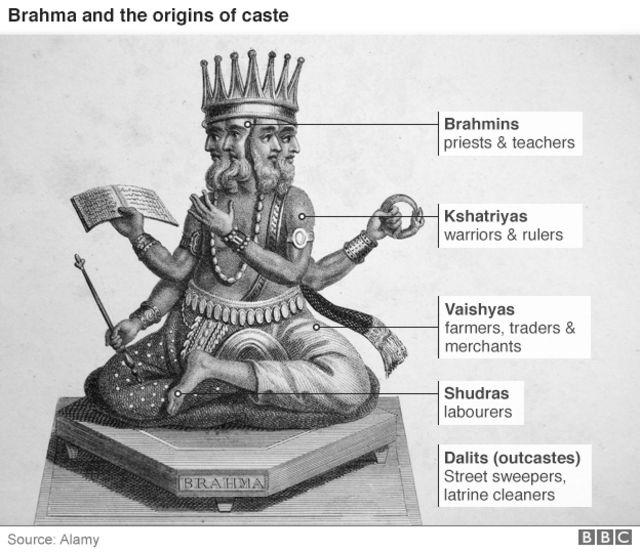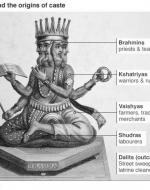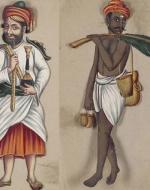Created by Mahum Zaidi on Wed, 11/10/2021 - 13:54
Description:
The Indian caste system is one of the most pervasive societal structures in the world, with origins dating back to as many as 3000 years ago. While it was outlawed in the 20th century by the founders of post-colonial India as a ratification to the constitution, its social, cultural, and economic effects are still felt in Indian society today, and many claim that it is still alive in the everyday lives of the country’s citizens.
Divided into five main levels, the system outlines a hierarchy whereby one’s caste (largely decided by birth) dictates rules regarding their relations, occupations, endogamy, and general practices. The history of caste stems largely from Hindu religion, but there are many interactions of note that have altered the practice, such as the Buddhist revolution and British rule. It is widely believed that the earliest beginnings trace back to the arrival of the Aryans in India around 1500 BC. Records of Indo-Aryan culture are not the earliest of the many that flourished in India, but they do contain the first mention and consistent evidence of the constituents that make up the caste system. The Aryans came from the regions of southern Europe and northern Asia with features such as fair skin that contrasted with native Indians. They possessed an already existing form of social ordering called Varna Vyavastha, based on four hierarchical divisions of function in society: religious and educational functions, military and political functions, economic functions, and menial functions. Legitimizing their rule, the Aryans laid out social and religious rules which stated that only they were allowed to become the priests, warriors, and businessmen of society. Furthermore, Aryans are described by what were considered “pure” and “noble” features: tall stature, sharp features, and light skin. Those considered of lowly origin and racial inferiority were the Dasyus, or Dasas, who had dark skin. Many sociologists look to these facts as explanations for the origins of colorism in the subcontinent as well; indeed, the word varna often used in the context of meaning “class,” directly translates to the word “color”.
The modern-day understanding of caste most directly comes from the Rig Veda, the most sacred ancient text of the Hindu religion. It functions as a story of creation, describing the division of the primordial being Purusha (also referred to as Brahma) into four castes, as shown in the image. Brahmins were born from the mouth, Ksatriyas from the arms, Vaisyas from the thighs and Sudras from the feet. Each one of these castes from the beginning was assigned a particular purpose and station in life. Brahmins (priests) were to recite and teach the Veda (religious texts), offer and officiate at sacrifices, and receive and give gifts, while Kshatriyas (warriors) were charged mainly with protecting others, and Vaisyas (merchants) were to engage in trade, money lending, and agriculture. There is an observed connection between the body part associated with each caste and their individual roles in the society (head for wisdom, arms for strength, etc.) There is an additional level on the hierarchy made up of the “Dalits” or “Shudras,” or untouchables, which comprise the lowest order and are often relegated the lowest jobs.
The most firm establishment of discrimination on the basis of class comes from the writing of the Law Code of Manu from the 2nd century CE. This code was one of the most influential of the Hindu dharmasastras texts, which detailed laws and instructions on how to live pure and pious lives. In fact, all of the laws in Manu’s Code were caste-based, with the severest punishments prescribed for Shudras, and the lightest for Brahmins. In medieval India, the text became the standard source of authority that solidified the Brahmins as the ultimate arbiters of all things earthly and holy while simultaneously denigrating the Shudra caste as the lowest level of society.
Image Source: Alamy. “Brahma and the Origins of Class.” BBC , 19 June 2019, https://www.bbc.com/news/world-asia-india-35650616. Accessed 10 Nov. 2021.
Works Cited:
Deshpande, Manali S. “History of the Indian Caste System and Its Impact on India Today.” California Polytechnic State University, 2010.
Kositsky, Sasha Riser. “The Political Intensification of Caste: India Under the Raj .” Penn History Review , vol. 17, no. 1, Dec. 2009, https://repository.upenn.edu/cgi/viewcontent.cgi?article=1012&context=phr. Accessed 10 Nov. 2021.
Mishra, Neha. “India and Colorism: The Finer Nuances .” Washington University Global Studies Law Review , vol. 14, no. 4, 2015, https://openscholarship.wustl.edu/cgi/viewcontent.cgi?article=1553&conte.... Accessed 10 Nov. 2021.
Olcott, Mason. “The Caste System of India.” American Sociological Review, vol. 9, no. 6, Dec. 1944, pp. 648–657., https://www.jstor.org/stable/2085128?origin=crossref&seq=1#metadata_info....
Ramesh, Kamboju. “Caste System and Political Change in Indian Democracy – A Study.” International Journal of Creative Research Thoughts , vol. 8, no. 11, Nov. 2020, https://www.ijcrt.org/papers/IJCRT2011075.pdf. Accessed 10 Nov. 2021.
Copyright:
Associated Place(s)
Timeline of Events Associated with The Indian Caste System: Origins and History
Part of Group:
Featured in Exhibit:
Artist:
- Alamy



